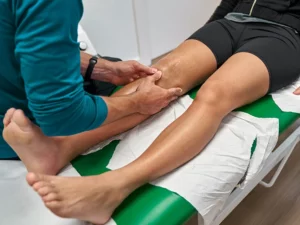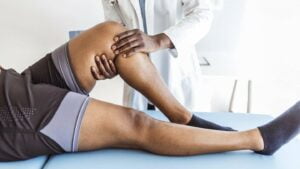The knee, while being one of the most robust joints in the human body. It is also among the most susceptible to pain and injury. Central to this joint is the knee cap or patella—a seemingly simple bone that plays a pivotal role in our mobility. However, when pain emanates from this region, it can hinder our daily activities and diminish our quality of life. This article delves deep into the intricacies of knee cap pain, unraveling its causes, manifestations, and potential solutions.
Contents
What Causes Knee Cap Pain Without Injury?
 Knee cap pain, often termed “patellofemoral pain syndrome” or “anterior knee pain,” is a common complaint. The pain typically arises from the patellofemoral joint, which is where the back of the patella (knee cap) articulates with the front of the femur (thigh bone).
Knee cap pain, often termed “patellofemoral pain syndrome” or “anterior knee pain,” is a common complaint. The pain typically arises from the patellofemoral joint, which is where the back of the patella (knee cap) articulates with the front of the femur (thigh bone).
Here are some of the common causes:
- Patellofemoral Pain Syndrome (PFPS)
Often termed ‘runner’s knee,’ PFPS is characterized by pain around and behind the knee cap. Particularly when climbing stairs, squatting, or sitting for extended periods. The pain usually arises from improper patella tracking, leading to increased stress and friction between the patella and the femur.
- Chondromalacia Patellae
This refers to the softening and subsequent breakdown of the cartilage on the underside of the patella. As the cartilage deteriorates, it can result in a painful grinding sensation and stiffness within the knee.
- Patellar Tendinitis
Known as ‘jumper’s knee,’ this condition involves inflammation of the patellar tendon, which connects the patella to the shin bone (tibia). It’s prevalent in athletes who are involved in sports that require frequent jumping, like basketball and volleyball.
- Patellar Subluxation/Dislocation
This condition pertains to the temporary or permanent dislodging of the patella from its usual groove on the femur. It can result from a traumatic injury, or in some cases, may occur spontaneously due to underlying anatomical variations.
- Patellar Fracture
A fracture or break in the patella typically results from direct trauma to the knee, such as a fall or significant blow. This injury can be extremely painful and usually inhibits leg movement.
- Osteoarthritis
This degenerative joint condition involves the wearing down of cartilage, which serves as a cushion between bones. As it pertains to the knee, osteoarthritis can lead to pain, stiffness, and reduced range of motion.
The inflammation of the bursa, a fluid-filled sac located just in front of the patella, can lead to swelling and pain in the knee cap region. This condition often results from repeated kneeling, direct trauma, or infections.
- Fat Pad Impingement
This occurs when the fat pad located below the patella becomes pinched between the patella and the femur, leading to pain.
- Sinding-Larsen-Johansson Syndrome
A type of osteochondrosis, this condition involves inflammation at the bottom of the patella, where the tendon attaches. It’s most common in adolescents and those involved in sports that require frequent jumping.
How Do You Treat Knee Cap Pain?
 Managing and treating knee cap pain requires a multifaceted approach that considers the underlying cause, severity, and individual needs of the patient. Here are some general strategies and treatments that can be effective for knee cap pain:
Managing and treating knee cap pain requires a multifaceted approach that considers the underlying cause, severity, and individual needs of the patient. Here are some general strategies and treatments that can be effective for knee cap pain:
- Rest and Activity Modification
Initially, it might be necessary to limit activities that aggravate the pain, such as squatting, jumping, or prolonged sitting. Giving the knee a break can prevent further injury and allow the area to heal.
A physical therapist can design a regimen that includes exercises to strengthen the muscles around the knee, particularly the quadriceps, hamstrings, and calf muscles. They can also provide stretching exercises to maintain flexibility.
- RICE Protocol
First is rest, in this, refrain from activities that cause pain. Then, apply cold packs for 20 minutes at a time, several times a day, to reduce inflammation. Lastly, wear a knee support or bandage to reduce swelling.
- Medication
Over-the-counter nonsteroidal anti-inflammatory drugs (NSAIDs), such as ibuprofen or naproxen, can help reduce inflammation and relieve pain. Always consult with a healthcare professional before starting any medication.
- Bracing or Taping
Patellar braces or tapes can help support the knee cap and maintain its alignment, reducing stress on the joint.
- Joint Injections
In cases of severe pain or inflammation, a doctor might recommend injections of corticosteroids or hyaluronic acid into the knee joint.
- Surgery
In rare cases, when other treatments fail, surgical procedures like arthroscopy can be used to treat the underlying cause of the knee cap pain.
- Alternative Therapies
Acupuncture, chiropractic care, and massage might offer relief for some individuals.
How Can I Prevent My Knee Cap Pain?
 Preventing knee cap pain largely centers around ensuring the knee remains strong, flexible, and protected from undue strain. Implementing these preventive measures can help stave off the pain or keep it from worsening:
Preventing knee cap pain largely centers around ensuring the knee remains strong, flexible, and protected from undue strain. Implementing these preventive measures can help stave off the pain or keep it from worsening:
- Strengthening Exercises: Incorporate strength training, particularly for the quadriceps, hamstrings, and calf muscles. A strong surrounding musculature can help support the knee joint, reducing the chances of injury.
- Flexibility: Regularly stretch your leg muscles to maintain flexibility. This can prevent imbalances and tightness that can pull the patella out of alignment.
- Avoid Overuse: Engage in varied physical activities to ensure you’re not overusing or straining specific muscles or joints. If you’re involved in repetitive knee activities, take regular breaks to allow your knees to rest.
- Proper Footwear: Wear shoes that offer good arch support and cushioning. For athletes, it’s crucial to wear sports-specific shoes. If you have flat feet or other foot issues, consider orthotic inserts to help distribute pressure evenly.
- Warm-Up Before Activity: Always warm up before any physical activity. This helps to prepare the muscles and increases circulation, reducing the risk of injury.
- Avoid Sudden Increases in Intensity: Gradually increase the intensity and duration of workouts. Sudden spikes in activity levels can lead to injuries.
- Good Form and Technique: Whether you’re exercising, playing sports, or doing any physical activity, using proper form and technique can prevent undue stress on the knees.
- Surface Awareness: Be cautious about the surfaces you run or walk on. Uneven or hard surfaces can place more strain on the knees.
- Stay Hydrated: Proper hydration aids in joint lubrication.
- Supplementation: Some people find supplements like glucosamine and chondroitin helpful for joint health, though research is mixed. Consult with a healthcare provider before starting any supplements.
Remember, the key is consistency. Regularly engaging in exercises and stretches, while being mindful of your body’s signals, can help in preventing knee cap pain.
Can Exercise Cure Knee Pain?
Exercise can be beneficial in managing and preventing knee pain. But it’s not a guaranteed “cure” for all types of knee pain. Physical activity strengthens the muscles surrounding the knee joint, providing better support and potentially reducing strain on the joint itself. Regular exercise can also improve joint mobility, maintain optimal weight (reducing stress on weight-bearing joints), and enhance circulation.
However, it’s essential to approach exercise with caution, especially if someone is already experiencing knee pain. Not all exercises are suitable for all types of knee conditions. For example, high-impact activities might exacerbate pain for people with osteoarthritis or other degenerative conditions. It’s crucial to consult with a physical therapist or healthcare professional to tailor an exercise regimen specific to individual needs and conditions.
Is Walking Good For Knee Cap Pain?
Walking is often recommended as a low-impact exercise that can be beneficial for individuals with knee cap pain. Regular walking helps to strengthen the muscles surrounding the knee, particularly the quadriceps and hamstrings, providing more support to the knee joint. A stronger musculature can reduce the stress placed on the knee cap, potentially alleviating pain and promoting joint health.
Furthermore, walking enhances circulation, ensuring that the knee joint receives adequate nutrients and facilitating the removal of waste products. However, it’s crucial to approach walking mindfully. Especially if one is already experiencing knee cap pain.
Wearing appropriate footwear with good arch support and cushioning is essential to distribute the impact and prevent additional strain on the knees. Moreover, it’s advisable to start slow and gradually increase walking duration and intensity. If pain intensifies or persists, it’s essential to consult with a healthcare or physical therapy professional to ensure that walking is appropriate and beneficial for one’s specific condition.
Conclusion
In conclusion, knee pain, while common, need not be a persistent hindrance in one’s life. By harnessing a range of natural strategies—from dietary adjustments to physical activity and alternative therapies—it’s possible to manage and even alleviate the discomfort associated with this ailment. As with any health concern, individual experiences will vary. So it’s essential to find what works best for your body and always consult with a healthcare professional before making significant changes to your routine or trying new remedies.
By understanding your body and being proactive in your approach, you can pave the way to healthier, pain-free knees. If you’re experiencing Knee pain, physical therapy for knee pain at PhysioMantra can help: Book an online physical therapy session.



